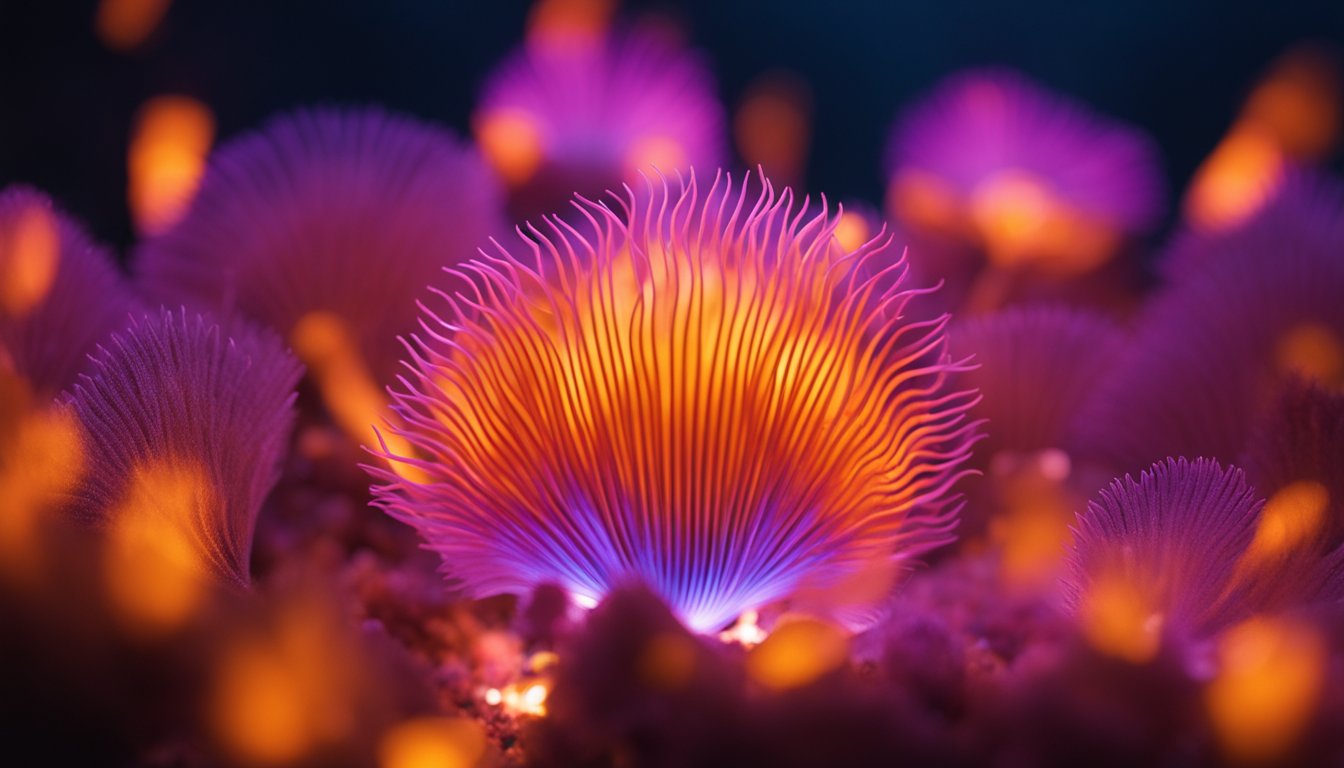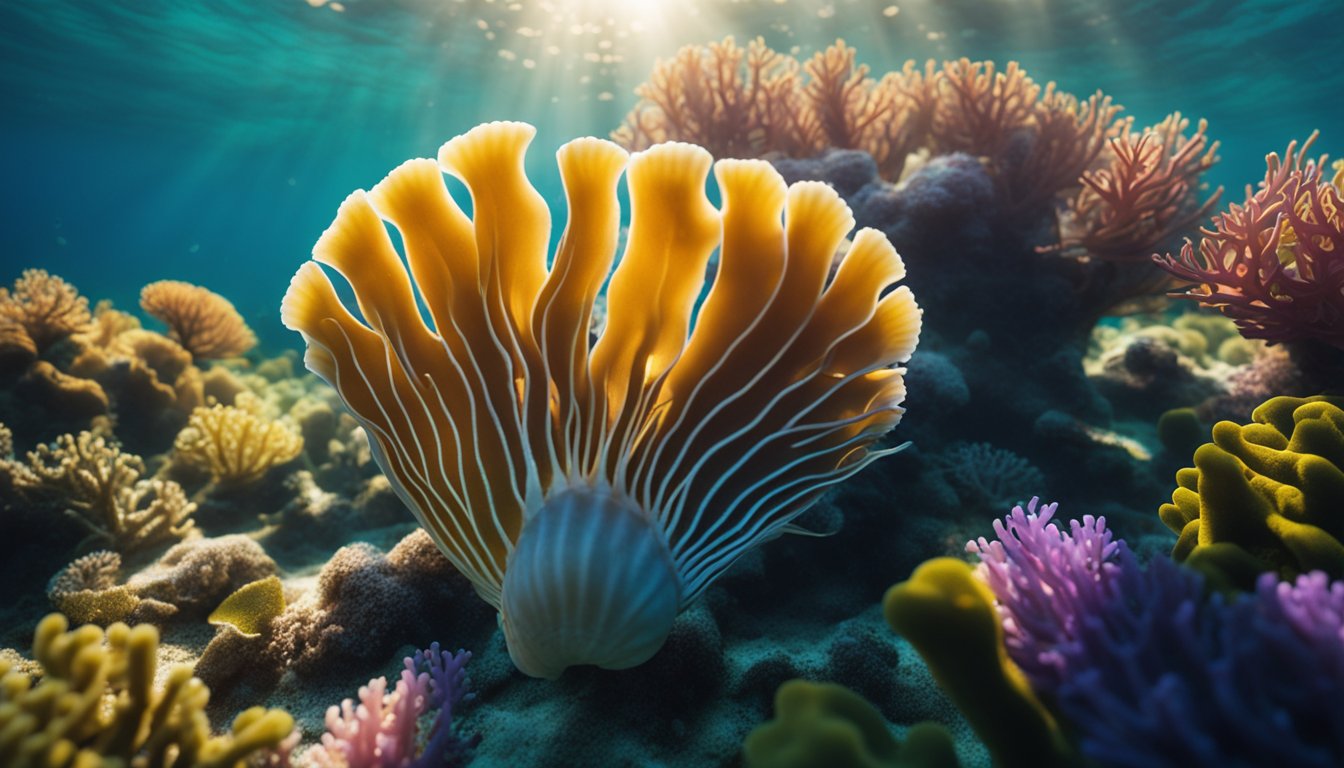Imagine you’re exploring the mysterious underwater world, a place where colorful creatures hide in every crevice, and there’s always something new to discover.
Among the ocean’s many secrets, we find the flame scallop, a bivalve that captures our attention not only with its vibrant red and orange mantle but with a captivating light show that looks like dancing flames.
It’s no wonder these creatures have become such a fascinating topic for us to explore.

The flame scallop lives in the murky depths of the ocean, usually hanging out on rocky surfaces or coral reefs.
It’s not very big, but what it lacks in size, it makes up for with its remarkable ability to create a flickering light effect.
Although it may seem like the flame scallop is performing a magic trick, there’s actually a scientific explanation for this.
The edges of its mantle have special tissues that reflect light, creating an illusion reminiscent of a flame—a truly mesmerizing sight in the underwater twilight!
As we get to know these sea-dwelling marvels, we discover there is much more to learn about the way they live, eat, and interact with their environment.
For instance, did you know that unlike some of their fellow mollusks, flame scallops are not fond of staying put?
They can swim away when they sense danger, clapping their shells together to jet through the water.
It’s these surprising behaviors and adaptations that make the flame scallop a subject of wonder for us all.
Join us as we dive deeper into the world of the flame scallop and uncover the secrets behind those dancing flames!
What Is a Flame Scallop?

Let’s dive into the world of the Flame Scallop!
Think of it as the underwater version of a fireworks show, lighting up its surroundings with vibrant colors and movements.
Colorful Appearance
When we peek under the sea, the Flame Scallop stands out with its fiery display.
Its mantle is adorned with bright red and orange tentacles that flutter like tiny flames—hence its name.
These scallops also have small, round, reflective eyes that shine along the edge of their open shells, creating an enchanting spectacle.
They’re not just pretty; these features help with both camouflage against predators and attracting mates.
Just like us trying to look our best, they use their appearance to survive and socialize!
Unique Habitat
Our Flame Scallop friends call the warm waters of the Caribbean and the Western Atlantic Ocean their home.
They love to nestle into nooks and crannies of coral reefs or hide under rocks on the ocean floor at depths of up to 100 feet.
This might seem deep, but it’s like their perfect basement hangout spot. They clamp onto surfaces using a byssus—a bunch of silk-like threads.
Think of it as their personal safety rope that keeps them from drifting away with the currents.
The Science of Dancing Flames

Before we uncover the secrets of the dancing flames, it’s good to know that they’re not actual flames, but rather a show put on by the incredible flame scallop.
Let’s dive into the wonders of bioluminescence and the unique dance of light and movement of these underwater marvels.
Bioluminescence Explained
Bioluminescence is nature’s own light show, and we see it when certain living things can make themselves glow.
The flame scallop has special organs that produce light. Imagine squishing a tiny glow stick when the flame scallop feels like it. That’s bioluminescence!
But instead of breaking a glow stick, the flame scallop uses chemicals inside its body to make light.
A chemical reaction happens between a substance in their bodies called luciferin and oxygen, creating this magical glow.
Movement and Light Patterns
Now, let’s wiggle our way into how the flame scallop moves.
These bivalves can clap their shells together which makes it look like they’re dancing! Each time they do this, light spreads around them in patterns.
It’s as if they are throwing their own underwater disco parties.
They have a special edge on their mantle that’s lined with tentacles, and this part glows.
When they snap their shells shut, the edge pulls in and out really quick, and it looks like little flames dancing around them, which is super cool to watch.
Flame Scallop’s Role in the Ecosystem

Flame scallops are like little underwater magicians that light up the sea floor with their dazzling red tentacles.
Think of them as important members of the sea’s neighborhood, contributing to the health and stability of their marine home.
Diet and Predators
Did you know that we flame scallops are filter feeders?
That means we get our meals by sifting through water, trapping tiny particles like plankton and other small organisms.
This may seem like a small act, but it’s a big deal for the ocean!
By filtering water, we help to keep it clean and clear, which benefits everyone in the ecosystem.
Our method of feeding also connects us to other parts of the food web.
Small fish and invertebrates might snack on us, and in turn, they become food for larger creatures. It’s all connected!
Reproduction and Life Cycle
Let’s talk about how we flame scallops make more of us.
We have a pretty incredible party trick – we’re hermaphrodites, meaning each one of us has both male and female reproductive organs.
When it’s time to reproduce, we release eggs and sperm into the water, where fertilization happens.
Then, our larvae float around with plankton before settling down to start their own lives on the ocean floor, continuing the cycle.
Through this process, we help to sustain our population, ensuring that flame scallops can carry on their role in the sea’s complex web of life for years to come.
Human Interactions

As we explore how we humans interact with the flame scallop, keep in mind their importance in the aquarium trade and the ongoing conservation efforts designed to protect these colorful creatures.
Aquarium Trade
You’ve probably seen those tiny creatures with bright red tentacles that seem to dance in the water, right? That’s our friend, the flame scallop!
We are so fascinated by them that we keep them in our home aquariums.
They’re not just another pretty shell; they’re living creatures that bring a little bit of the ocean’s wonder into our lives.
But, we have to remember that they need specific water conditions to do their flashy dance.
Flame scallops prefer water that’s clean, well-oxygenated, and just the right temperature.
Conservation Efforts
Did you know that every one of us can play a part in conserving the flame scallop?
These little dancers are sensitive to changes in their environment, so it’s up to us to make sure their ocean home stays clean and healthy.
This means being careful with what we put down our drains and standing up for protecting ocean habitats.
There are people who work every day to monitor the health of marine life; they keep an eye on the numbers of our flame scallop friends and help make sure they have safe places to live and thrive.
Frequently Asked Questions
We often find ourselves curious about the remarkable creatures that inhabit our oceans, and the flame scallop is no exception with its spectacular display that looks like a dance.
Let’s explore some of the questions we frequently ask about these fascinating marine bivalves.
What makes the flame scallop move like it’s dancing?
The flame scallop has a unique way of locomotion that seems as if it’s performing a dance.
We see this aquatic ballet when the scallop rapidly opens and closes its shells, pushing water out that propels it through the ocean.
It’s quite a sight, almost like it’s fluttering through the water to its own beat.
Can I have a flame scallop in my home aquarium, and if so, how do I care for it?
Yes, we can keep flame scallops in our home aquariums, but they require specific care to thrive.
They need clean, well-oxygenated water and moderate lighting.
We also need to ensure they have a steady supply of fine particles of food, as they are filter feeders.
Keeping the water conditions stable is crucial for their well-being.
What does the flame scallop eat, and where is its natural habitat?
Flame scallops are filter feeders; they eat tiny food particles from the water, which they capture with their gills.
Their natural habitat is the coral reefs and sea grass beds of the Caribbean and Western Atlantic, where they find plenty of the plankton they feast on.
Why do flame scallops have such bright and colorful mantles?
The bright and colorful mantles of flame scallops are awe-inspiring. We believe these vibrant colors and patterns might be a way to scare off predators.
When a predator nears, the sudden flash of color might startle it, giving the scallop a chance to ‘dance’ away.
How long can a flame scallop live, and can they interact with other sea creatures?
Flame scallops can live for several years with proper care.
While they are not social creatures in the same way fish might be, they do share their habitat with a variety of other marine life.
It’s essential for us to maintain a harmonious tank if we keep different species together, making sure all inhabitants have their needs met.
Does the flame scallop truly emit light, and how does this phenomenon occur?
It’s a common misconception that the flame scallop emits light.
What appears to be light emission is actually light reflecting off their bright red tentacles and mantle edges.
This reflection occurs when the scallop moves, creating an illusion of sparks or flames, which is how it gets its fiery name.




